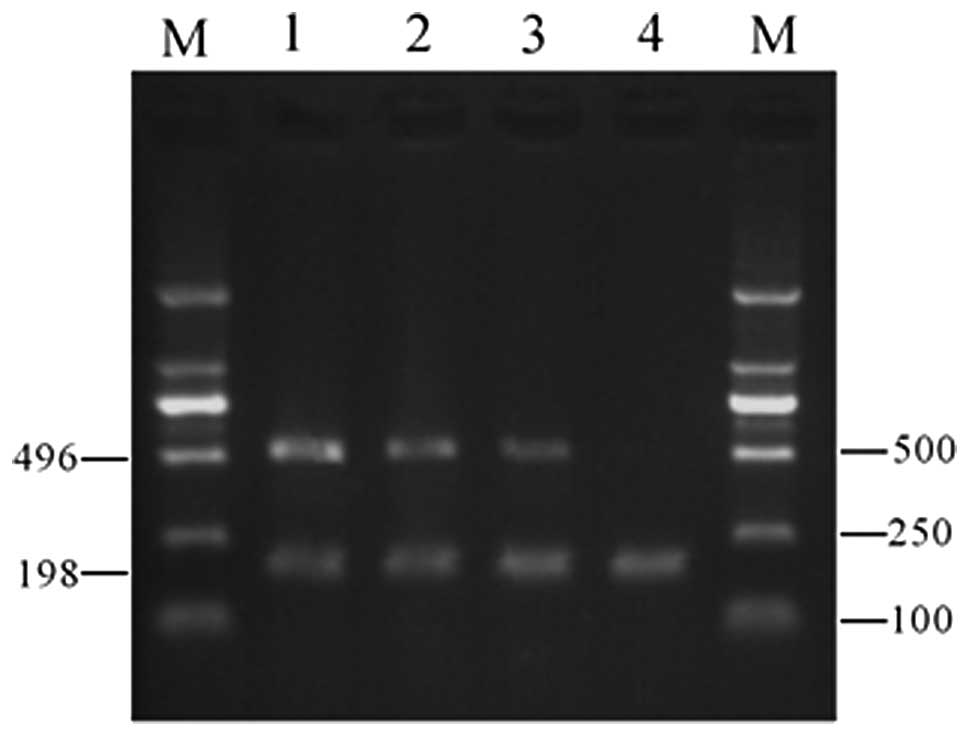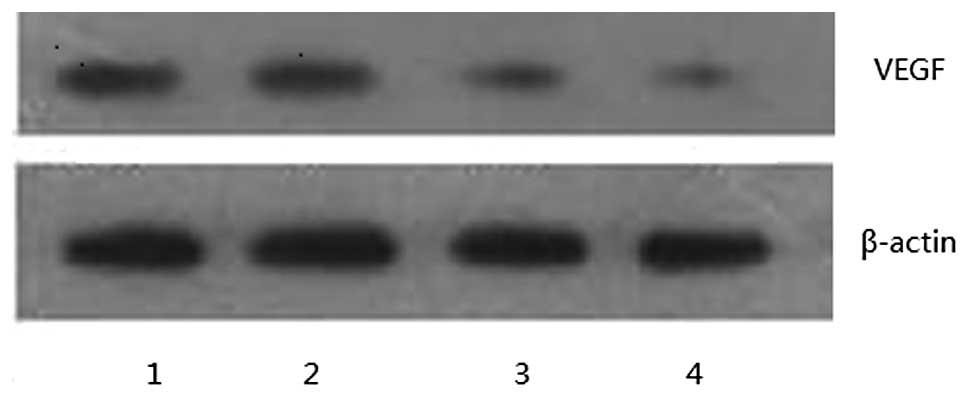Effects of resveratrol on vascular endothelial growth factor expression in osteosarcoma cells and cell proliferation
- Authors:
- Published online on: July 25, 2012 https://doi.org/10.3892/ol.2012.824
- Pages: 837-839
Abstract
Introduction
Resveratrol (Res), chemically named 3,4′,5-trihydroxystilbene, is a non-flavone polyphenolic compound which mainly exists in plants, including grapes, Veratrum nigrum and giant knot-weed rhizome. It was first extracted from European Resveratrol (Res). Res, a type of phytoalexin, is extensively present in nature and is produced by plants under conditions of fungal infection, ultraviolet radiation or pathology. Res possesses multiple bioactivities, including antioxidation, antiinflammation, estrogen-like activity, growth inhibition, immunoregulation, chemoprevention and antitumor activity (1). Res blocks several processes of carcinogenesis and has inhibitory effects on the initiation, promotion and development of tumors (2). However, previous studies have shown that the inhibitory effect of Res on cancer cells varies between cancer types and that Res only inhibits the cell growth of certain types of cancer (3,4). Res has an inhibitory effect on leukemic osteosarcoma and lung, prostate, colon, pancreatic, liver and breast cancer (5–10); however, its mechanism of action remains unknown.
Angiogenesis is one of the prerequisites of the proliferation and growth of tumor cells. During this process, vascular endothelial growth factor (VEGF) functions as the most significant vascular endothelial stimulating factor; VEGF overexpression is correlated with patient survival rate and the early relapse, infiltration and lymph node metastasis of tumors (11–13). Osteosarcoma is a malignant invasive disease which occurs among young individuals. The molecular genetics of this medical condition have been elucidated over recent years. The development of osteosarcoma is associated with simultaneous changes in multiple genes, for instance, the cooccurrence of mouse double minute 2 (MDM2) amplification and p53 deactivation promote the initiation and development of osteosarcoma (14).
In the current study, the effects of Res on osteosarcoma cell growth and VEGF expression were investigated and the mechanism of action of Res was further explored.
Materials and methods
Cell culture
The human osteosarcoma cell line U20S was cultured with 10% fetal bovine serum-containing DMEM in a 5% CO2 incubator at 37°C and then digested with 0.25% trypsin for subculture.
Methyl thiazolyl tetrazolium (MTT) assay
Cells in the logarithmic growth phase at a concentration of 1.5×104 cells/ml (200 μl) were seeded onto a 96-well plate for 24 h. Res (0, 10, 20 and 40 μmol/l) with a purity of 99% (Sigma, St. Louis, MO, USA) was added, with four wells for each group. The cells were cultured for 24, 48 and 72 h, respectively. The culture medium was removed and 20 μl of MTT (5 g/l) was added to each well for a 4-h culture. The medium was removed and dimethyl sulfoxide was added to dissolve the crystals. The absorbance of the solution at 570 nm (A570 nm) was read and the cell inhibition ratio was calculated as follows: cell inhibition ratio = [(A570 nm value of the control group - A570 nm value of the experimental group)/A570 nm value of the control group] x 100%.
Real-time polymerase chain reaction (RT-PCR)
Based on GenBank (AF022375.1), the primer sequences of human VEGF were designed using the Primer 5.0 software: 5′- CA AGTG GTCCCAG G CTG CAC-3′ (upstream) and 5′-CGCGAGTGTGTGTTTTTGCAGG-3′ (downstream). GAPDH was taken as the internal standard and the primer sequences were as follows: 5′-AAAGTGGATATTGTTGCCATC-3′ (upstream) and 5′-CAAATGAGCCCCAGCCTTCTCC-3′ (downstream). Syntheses were performed by Sangon Biotech Co., Ltd. (Shanghai, China). The amplification fragment length of GAPDH was 198 bp. The concentration of the VEGF cDNA original templates was standardized according to that of the GAPDH cDNA original templates and cDNA-free wells were used for negative controls.
Total RNA was extracted with TRIzol reagent. A260 and A280 values were read on the ultraviolet spectrophotometer, RNA was qualified using agarose gel electrophoresis and the rest of the RNA was stored at −80°C. cDNA was reverse transcribed in line with the manufacturer’s instructions (Shanghai Biology Engineering, Shanghai, China) and the products were kept at −20°C. The reaction system, with a volume of 30 μl, contained 1 μl of the reverse-transcribed products, 1 μl of VEGF primers, 1 μl of GAPDH primers, 3 μl of 10X bufer, 2 μl of 2.5 mmol/l dNTP and 2 units of Taq polymerase. The amplification conditions consisted of a pre-denaturation step at 94°C for 3 min, 35 cycles of 94°C for 30 sec, 55°C for 30 sec and 72°C for 1 min and a final extension step at 72°C for 5 min. In the interest of quantitation, GAPDH and VEGF were amplified at the same time. The amplified products were observed following 1.5% agarose gel electrophoresis and ethidium bromide (EB) staining. Total A value (average A value x band area) was taken as the quantity of mRNA and VEGF mRNA expression and was then calculated based on the A value ratio between VEGF and GAPDH.
Western blot analysis
Cells in each group were collected, sonicated slightly for 10 sec and centrifuged for total protein samples. Concentrations were determined using a Bio-Rad DC protein assay kit (Shanghai Biology Engineering). The protein sample (50 g) was fractionated by 12% SDS-PAGE and transferred to a polyvinylidene difluoride membrane. The membrane was treated with skimmed milk for 2 h and incubated with rabbit antibody against human MDM2 (1:200 dilution) at 37°C for 2 h. Following washing in TBST for 30 min, the membrane was incubated with goat anti-rabbit antibody (1:1,000 dilution) at 37°C for 1 h. Following washing in TBST for 30 min, the membrane was colored and images were captured.
Statistical analysis
Data are presented as mean ± SD and were analyzed using the SPSS 12.0 software. P<0.05 was considered to indicate a statistically significant difference.
Results
Inhibitory effect of Res on U20S
The MTT assays revealed that Res had an inhibitory effect on U20S at each concentration; the inhibitory effect was strengthened with the increase of the Res concentration as well as with the prolongation of action time, showing time- and dose-dependent characteristics (Table I).
RT-PCR
The purity of total RNA was assayed using the ultraviolet spectrophotometer. The results revealed that all the A260/A280 ratios fell between 1.9 and 2.0, satisfying the requirements for the experiment.
Gel electrophoresis revealed that VEGF expression in the 10 μmol/l Res group was significantly lower than that in the control group; in the 40-μmol/l Res group, VEGF expression was not detected (Fig. 1). These results indicate that Res inhibits VEGF mRNA expression within a certain concentration range.
Western blot analysis
Western blot analyses demonstrated that VEGF expression in the 10- and 20-μmol/l Res groups was significantly lower than that in the control group and no VEGF expression was detected in the 40 μmol/l Res group (Fig. 2). These results were consistent with the RT-PCR results, indicating that Res has an inhibitory effect on VEGF protein expression in U20S.
Discussion
Res is a non-flavone polyphenolic compound which is extensively present in plants and is abundant in red wines. In recent years, Res has attracted much attention from researchers and has become a hotspot in the prevention of tumors. Res inhibits tumor cell proliferation by reducing the number of G-phase cells and blocking S-phase cells (15). Res shows a bidirectional effect on the cell proliferation of prostate, breast, pancreatic and esophageal cancer, namely, a low concentration of Res promotes cell growth while a high concentration inhibits the growth (15–18).
Osteosarcoma is a primary malignant bone tumor with a strong invasive power, which occurs most commonly among young individuals. This disease is characterized by organ metastasis at an early stage and has a high relapse rate following surgery. Therefore, the study of the mechanisms of osteosarcoma invasion and metastasis, as well as other related factors, have become hot topics in the field of osteology. The proliferation, invasion and metastasis of tumor cells, as well as tumor relapse, are correlated with the interactions among multiple factors, in which angiogenesis is a prerequisite. VEGF and basic fibrolast growth factor perform significant roles in angiogenesis (19,20).
In the present study, the MTT assays revealed that Res has an inhibitory effect on osteosarcoma cell proliferation and that this effect is strengthened with the increase of Res concentration as well as with the prolongation of Res action time, showing time- and dose-dependent characteristics. The RT-PCR and western blot analysis performed in this study further confirmed that Res inhibits VEGF expression within a certain concentration range in U20S cells. These results suggest that Res exerts its anti-osteosarcoma function by inhibiting VEGF expression in tumor cells.











